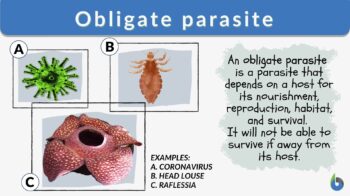
Obligate parasite
n., plural: obligate parasites
[ˈɑblɪɡeɪt ˈpærəˌsaɪt]
Definition: a parasite that depends on the host for its survival
Table of Contents
Parasitism is a form of symbiosis that occurs between a parasite and its host. The parasite is the organism that generally benefits from the relationship and it derives the benefits at the expense of the host. It may depend either partially or entirely on its host to complete its life cycle.
The parasite that depends entirely on its host is called an obligate parasite whereas the parasite that does not rely entirely on a host is referred to as a facultative parasite. Because it is obligate parasitism, keeping the host “alive” is essential because the parasite needs the host for its growth and reproduction.
Perhaps, the exception is when the death of the host involves the transmission of the parasite to another host. (Combes, 1997) But generally speaking, many obligate parasites (or obligate symbionts) need their host in order to survive. If kept away from the host, that could mean the death of the parasite.
Obligate Parasite Definition
What is an obligate parasite? In biology, an obligate parasite is a parasite that depends completely on the host for its habitat, nourishment, reproduction, and survival. Without the host, it will eventually die. In contrast, in facultative parasitism, the parasite may live in the absence of a host and occasionally become parasitic under certain conditions. This type of parasite is referred to as a facultative parasite.
So how do we define an obligatory parasite? The obligate parasite is an organism that will not thrive and thereby cannot reproduce outside a host. The obligate parasite is also known as holoparasite. Facultative parasites, in turn, are free-living but they may become parasitic if there is an opportunity to infect a host. An example of a facultative parasite is Naegleria fowleri, a free-living amoeba that on some occasions may infect humans.
Is a virus a parasite? Viruses are obligate parasites. They cannot reproduce outside living cells. Therefore, they are considered obligate intracellular parasites. They infect a host cell to use its genetic machinery to produce energy, synthesize proteins, and replicate.
So, between facultative and obligate parasites, what type of parasite would need a host to survive? An obligate parasite! It needs a host for its survival and so it is essential for a parasite to be compatible with its host. Otherwise, the parasite is at risk of dying if its host eventually dies from the association.
For more examples of obligate parasites, see Obligate Parasite Examples.
An obligate parasite is a parasite that entirely depends upon a host for its nourishment, reproduction, habitat, and survival. Examples: hookworm, Plasmodium, head louse, cuckoo paper wasp, Rafflesia. Synonym: obligatory parasite; holoparasite. Compare: facultative parasite
Host-parasite Interaction
Parasites have the ability to change the dynamics and structure of the host environment, however, the host environment can also affect the parasite. We can understand the interaction between the host and the parasite by knowing the differences between the host and parasite, then by comparing such variations with other factors influencing the relationship between a parasite and its host.
Life cycle
What are the types of life cycles of parasites? There are two types:
- Direct life cycles are when a parasite infects one species of hosts. Example: hookworm.
- Indirect or complex life cycles are when a parasite infects more than one species. Example: Plasmodium, a protozoan that causes malaria in humans, parasitizes mosquitoes and uses them as vectors to reach humans, the definitive host.
Intermediate or final Host
In an indirect life cycle, the parasites infect a secondary or intermediate host. Nevertheless, this only takes place for a short period of time usually during the transition periods. That’s because the parasite will reach maturity (i.e., the stage at which it becomes capable of sexual reproduction) when it’s able to parasitize its primary or definitive host.
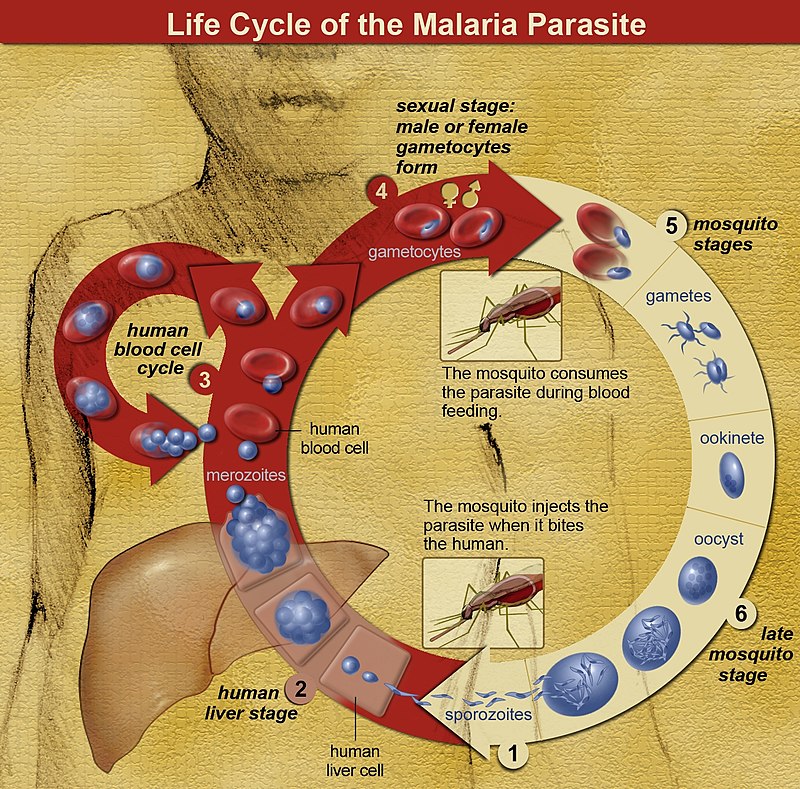
Parasitic permanence
Some obligate parasites may spend their entire life cycle on their host. An example of that is the head louse (Pediculus humanus capitis). This insect is an obligate ectoparasite of humans. They thrive and spend their entire life cycle on their human host. Thus, they are permanently parasitic. They won’t be able to survive outside their host for more than 24 hours. (Mumcuoglu et al., 2020)
Other obligate parasites need not spend their entire life cycle inside their host. For example, an obligately parasitic hookworm, Necator americanus, will spend part of its life cycle in the soil and then parasitizes a human host by penetrating the skin.
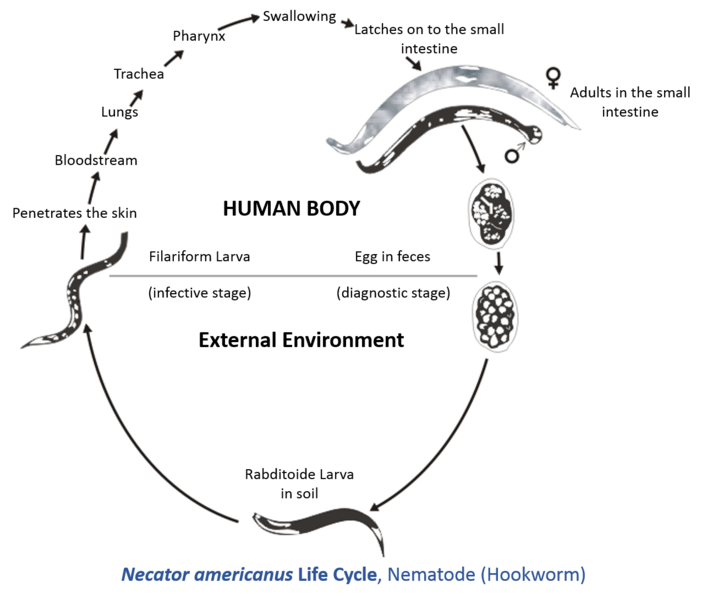
Location on host
Where can parasites be found in a host?
- Ectoparasites are parasites that live outside the host body, such as ticks.
- Endoparasites live inside the host body, such as the fluke.
- Brood parasites do not have direct contact with the host. Rather, they may be raised by the host, such as a cuckoo.
Invasion strategies
In order to invade a host, obligate parasites must be able to evade the host’s immune system. Intracellular parasites, such as infective bacteria and viruses, rely on passive uptake — that is, they rely on host cells taking them up. Once inside, they employ mechanisms (e.g., by disrupting cell signaling) to avoid detection.
Other intracellular parasites employ a more aggressive strategy. Apicomplexans, for instance, actively enter a host cell and do not wait for the latter to pick them up. Another example is the wasp Polistes atrimandibularis. P. atrimandibularis queen wasp modifies its own chemical signature to resemble that of the host’s chemical signature. Thus, it can successfully infiltrate the hosts’ colony and trick the hosts into thinking the parasitic queen is one of their own.
Watch this video to learn more about P. atrimandibularis (cuckoo paper wasp) as an obligate parasite and as an example of brood parasite.
Evasion of host defenses
Intracellular obligate parasites can evade cellular defense mechanisms of the host such as by surviving in certain compartments of the cell. Another method of evasion is the ability of the parasite to increase the apoptosis of the cell leading to cell death and reducing cellular replication.
Manipulation of Host Behavior
The behavior of the host may be changed after being infected with some obligate parasites. For example, unusual behavior is extremely common in individuals having parasitic infections, such behaviors may have benefits for parasitic transmission. Other behaviors manipulating the host may not benefit the host or the parasite. For example, after being infected with Toxoplasma gondii, rats become attracted to cat urine, which is an unusual behavior of rats. Watch the video below to learn about T. gondii, the agent of toxoplasmosis.
Extended phenotype
Extended phenotype refers to the change in behavior affecting the host that is usually due to the expression of the parasite genes, not the host genes.
Evolution of host behavior manipulation
Host behavior is manipulated by the parasite by three main routes of evolution. Where the first is driven by the parasite and then the second and third are driven by the host.
- The manipulation with extended phenotype strategy where the abnormal behavior of the host occurs due to the expression of parasitic genes. This phenomenon may result from the natural selection of the ancestors of parasites with this specific trait.
- The mafia-like strategy
- The induction of host compensatory mechanisms may serve the parasitic transmission. For example, the increase in sexual behavior in males infected with the sexually transmitted parasite Chrysomelobia labidomerae increases the spread of the parasite through sexual contact.
Behaviors resulting from extended phenotypes are not adaptive. Even though such behaviors can produce benefits to the parasite, however, these benefits are not intended.
Parasitic Mimicry in Brood Parasites
The cuckoo paper wasp (which is already mentioned above) and cowbirds do not have direct contact with the host, but they rather need the host to provide parental care for their young to develop. These parasites are known as brood parasites.
The parasitic cowbird produces eggs with the same colors and patterns as the host. This is to decrease the rejection of the parasitic bird’s egg. Young individuals can manipulate the behavior of the host by making calls with sounds that mimic sounds of the host young individuals.
Parasitic mimicry is also present in some bumblebee species. The parasite can change its identifying chemicals and cuticular hydrocarbons to match those of the targeted host. Another example of mimicry in brood parasites is that some butterfly species can act as parasites for ants where they excrete certain cuticular hydrocarbons that mimic those of the ant so the ant adapts the larva of the butterfly in its nest and feeds it until it grows up.
Obligate Parasite Examples
Here are some of the examples of obligate parasites.
In plants
Hemp broomrape is a parasitic plant that attacks crops including tobacco and tomatoes for nutrition. Some obligate plant parasites live inside the host entirely without revealing themselves unless they need to flower. An example of this obligate parasite is Rafflesia, which is an endoparasite that appears in the form of a single flower.
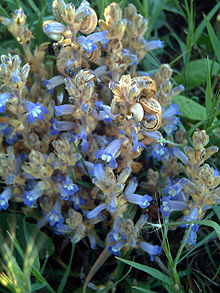
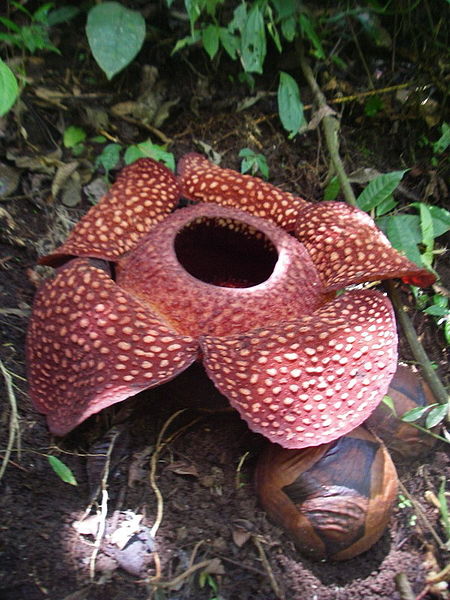
In bacteria
Are bacteria parasites? Not all bacteria are infective and therefore not parasites. There are bacteria that thrive in nature even without a host. Infective or pathogenic bacteria, on the other hand, may be regarded as parasitic based on the premise that they depend on the host for nutrition, development, survival, and protection.
Some references though do not regard bacteria as parasites although they are infective or pathogenic. But for others that regard them as parasitic (Encyclopædia Britannica, 2021), some examples would be are streptococci and staphylococci.
Treponema pallidum is a parasitic bacteria that can only grow in an animal cell because it needs low levels of oxidation-reduction and low oxygen tension levels. Usually, a pathogenic bacteria is an obligate pathogen, it is mostly found with its hosts.
Viruses
All animal viruses are obligate parasites; they cannot generate energy or multiply on their own. Viruses lack the metabolic machinery that exists in the cell. Thus, they depend on the host in performing vital functions such as energy production, protein synthesis, and multiplication.
Viruses have a core nucleic acid structure that is incorporated into the host cell to control its metabolic machinery to serve the parasite. This core is surrounded by a capsid which is a protein coat that protects the genetic material.
Try to answer the quiz below to check what you have learned so far about obligate parasites.
References
- Combes, C. (1997). Fitness of Parasites: Pathology and Selection International Journal for Parasitology 27(1): 1-10.
- Encyclopædia Britannica. (2021). parasitism | Definition & Examples | Britannica. (2021). In Encyclopædia Britannica. https://www.britannica.com/science/parasitism.
- Encyclopædia Britannica, inc. (n.d.). Encyclopædia Britannica. https://www.britannica.com/science/obligate-parasite.
- Garcia-Longoria, L., Marzal, A., De Lope, F., & Garamszegi, L. (2019). Host-parasite interaction explains variation in the prevalence of avian haemosporidians at the community level. PloS One, 14(3), e0205624.
- Mumcuoglu, K. Y., Pollack, R. J., Reed, D. L., Barker, S. C., Gordon, S., Toloza, A. C., Picollo, M. I., Taylan‐Ozkan, A., Chosidow, O., Habedank, B., Ibarra, J., Meinking, T. L., & Vander Stichele, R. H. (2020). International recommendations for an effective control of head louse infestations. International Journal of Dermatology, 60(3), 272–280. https://doi.org/10.1111/ijd.15096
- Obligate parasite. Obligate Parasite – an overview | ScienceDirect Topics. (n.d.). https://www.sciencedirect.com/topics/medicine-and-dentistry/obligate-parasite.
©BiologyOnline.com. Content provided and moderated by Biology Online Editors.



